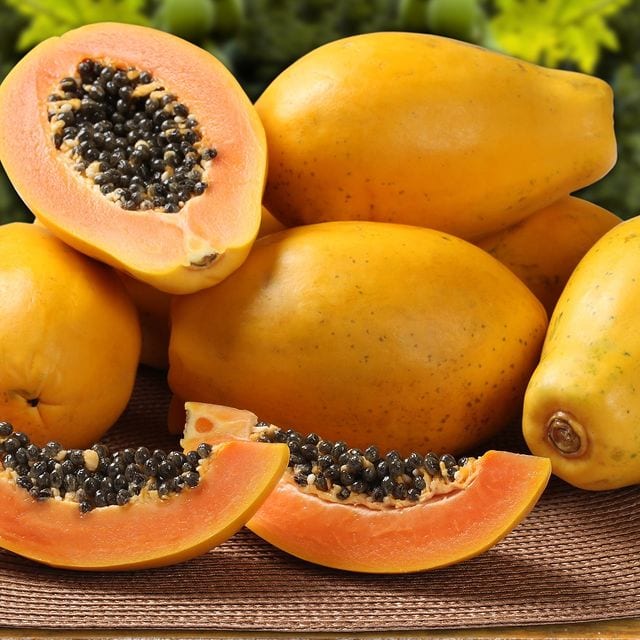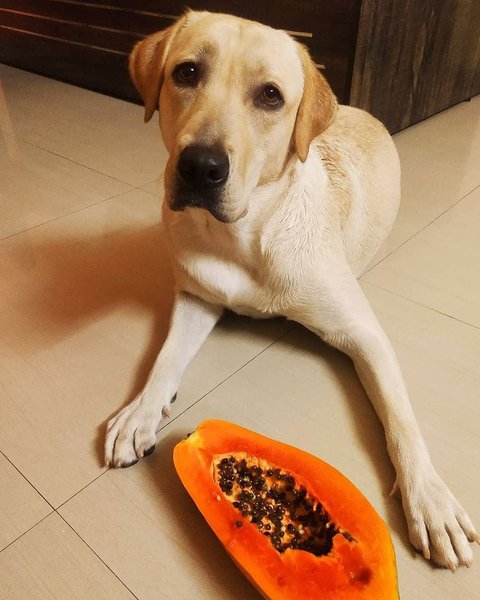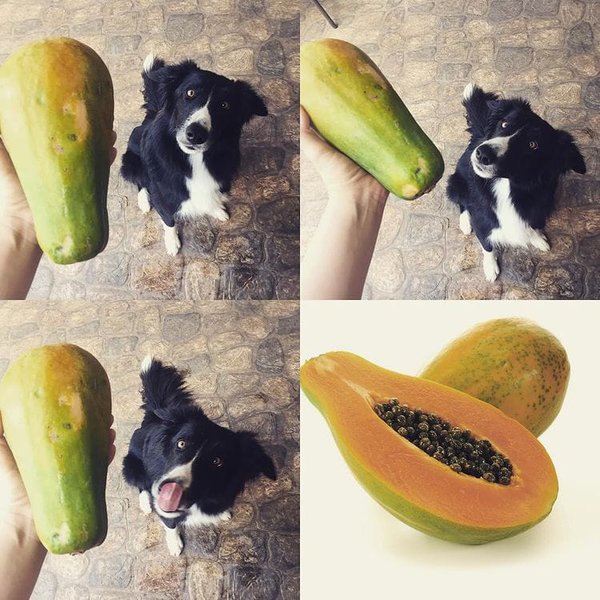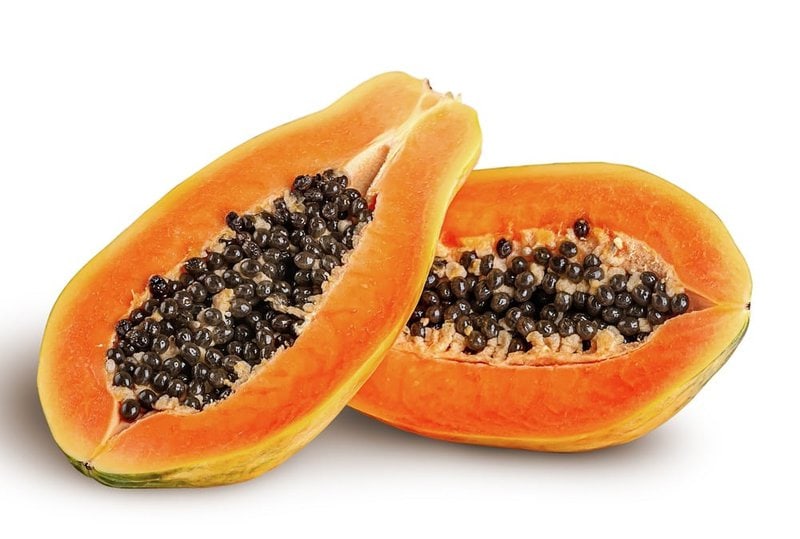A lot of dogs have never been told “NO!” When it comes to people’s food, when these dogs are being handed a whole slice of papaya during the fruit’s peak season, they naturally want to take a big ol’ bite.
But what happens when your dog takes a chomp out of this tropical fruit? Can dogs really eat papaya?
Yes, your dog can have papayas as they are rich in vitamin C, vitamin K, fiber, potassium, and other minerals beneficial to a dog’s health. Papayas help build a dog’s immune system by preventing infections and other fatal diseases. Also, they boost metabolism and are effective for removing intestinal worms.
So, if you have always been concerned about giving papayas to your doggie, then rest assured. It is safe for your furry friend to have papayas. In this article, we will provide you with a deep insight into the benefits of papaya. Other than that, you will also know precisely how much papaya you can give your doggie without harming its health.
So, without further ado. Let’s get right into it.
Can You Give Papaya To A Puppy?

Papayas are a great source of nutrients, fiber, moisture, and enzymes that help alleviate indigestion.
Papaya is a delicious fruit, but for most of us, it is not available in our kitchen daily, except during summers. It’s always better to provide fresh food items to your dog rather than processed dog food from stores because it will benefit your pet in more ways.
Papaya is rich in enzymes known as papain and chymopapain, which break down proteins in the intestine and help put it to use by increasing absorption of essential nutrients.
It also acts as a probiotic to get rid of harmful bacteria from the body. You can feed your dog with papaya fruit by giving it as is or in the form of its juice.
Here are some of the other benefits of papaya.
Strengthens Immune System
Papayas have plenty of vitamins, such as vitamin C, K, A, E, and several other antioxidants that help in strengthening your pup’s immune system and boosting its energy.
Here is how papaya helps in boosting your dog’s immune system.
Prevents Heart Disease
Papaya has lycopene and vitamin C, which lower the risks of heart diseases. 3.5 oz of papaya has 60 mg vitamin C, making it one of the fruits most enriched in vitamin C content. Moreover, it also has several compounds that maintain the cholesterol level.
Fights Oxidative Stress
Papaya also has carotenoid, which is a potent antioxidant. This oxidant neutralizes the free radicals in your canine’s body cells, thus increasing its immunity.
Fights Constipation
Papaya is full of soluble and insoluble fibers. The soluble fibers in papaya nourish the gut microbe—these also help in reducing cardiovascular diseases.
On the other hand, the insoluble fibers in papaya add bulks to your dog’s stool. By doing so, regularizes bowel movement and prevents constipation.
Prevents Obesity
The fiber content in papaya helps create a feeling of fullness in your dog for longer, thus reducing your doggie’s food portion. By adding papaya to your canine’s meal, you will notice that the gap between its meals will increase.
Prevents Cancer
Papaya has lycopene, decreasing cancer risks by reducing the free radicals. Based on research, papaya was the only fruit with anti-cancer properties among 14 other vegetables and fruits.
Promotes Bone Growth
Vitamin K plays an essential role in bone metabolism and regulates blood calcium levels. Studies have shown that a low intake of vitamin K increases the chances of bone fracture.
Papaya has a large amount of vitamin K in it. By adding papaya to your canine’s diet, you would feed it healthy fruits and increase the calcium absorption in its blood. In addition, an adequate amount of vitamins will make your pup’s bones strong enough to prevent fracture.
Reasons Why Should Your Dog Not Have Papaya
Although papaya has plenty of benefits for your pup, it still has some downsides in some situations.
- First of all, dogs can be prone to some food allergies. In turn, these allergies may cause stomach upsets and vomiting.
- This fruit contains natural latex that can unpleasantly affect feeding dogs’ digestive systems, resulting in diarrhea or vomiting.
- Some dogs are lactose intolerant or sensitive to sucrose (sugar), so they cannot have any fruit, let alone papaya.
- Papaya is not suitable for puppies under six months old because their immature digestive system can get irritated.
- It is not suitable for dogs with already upset stomachs.
- Papaya is also an acidic fruit, so it can increase the acidity level of their body and affect their teeth enamel. As a result, you should avoid giving your dog papaya if it has sensitive teeth or dental problems.
In general, it’s not safe for dogs having any disease mentioned above to eat papaya. However, you can consult your vet about the amount of this fruit that your pet can consume without causing any health issues.
You should also consider that foods with a lot of sugar in them are not the best choice for your pet to eat. Other health issues like diabetes, dental problems, and obesity can occur if you give your pup too much sugar every day.
How Many Papayas Can You Give A Dog?

One to two slices are enough for your doggie if it is medium-sized. You can also measure it as half a gram of papaya per one pound of your dog’s weight.
Although it is okay to feed papaya to your canine, you should still go easy on your furry friend. Consuming too much papaya can cause diarrhea and stomachaches in the dogs, so make sure not to go overboard.
You can feed papaya to your canine in the following three ways.
Freshly Chopped
The best way to feed papaya to your dog is by cutting fresh papaya into small pieces. Your doggie will have all the benefits of papaya while it’s still fresh. Here’s a quick way of preparing it.
- First, set up a cutting board, knife, a bowl of water, and some paper towels.
- Then simply use the same cutting board you are using to chop the papaya to slice off a small piece of the fruit.
- Place that in the bowl of water to keep it fresh and clean, then proceed to cut up the rest of your papaya.
- Next, place all the chopped pieces in a bowl and cover them with plastic wrap.
- Leave your dog’s papaya in the fridge for up to three days.
However, try these two methods if you find it hard to arrange fresh papaya very often.
Frozen Papaya
There is no significant difference between fresh and frozen papaya, except temperature. Moreover, dogs love crunchy food, so will your pup. You can slice papayas and then freeze them into tiny pieces that the puppy can eat later. All you have to do is:
- Buy big papaya for between $2 and $3, but you can also get an organic one for about $5.
- Now, cut it up and freeze it in cubes.
- Once it’s frozen, store them in a container.
- For the fun part, take one piece, cut up tiny bits, and sprinkle them over your pup’s food.
TIP: Make sure to take them out of the freezer when you order your groceries or buy your papaya. In this way, it’s not super frozen when you give it to your pup.
Also, feeding frozen papaya to a senior dog will not be a good idea since they can’t eat hard treats.
Dried Papaya
You can feed your pup a small portion of dried papaya by simply preparing them in your oven. Here’s how:
- Preheat the oven to its lowest setting (usually around 170 °F to 200 °F).
- Peel and slice up ripe papaya into rings, spreading them evenly on a baking sheet.
- Place in the center of your oven and let cook until they are dry and chewy around 30 hours.
- Your dried papaya should be crispy when done, not at all moist or squishy. It’s crucial to ensure the papaya is thoroughly dry before storing it in a cool place to prevent molding!
However, dried papaya is not safe for some dogs due to its high sugar content, which increases blood sugar levels. So, if your dog has diabetes, pancreatitis, or arthritis, you should avoid feeding it dehydrated papaya.
Can Dogs Eat Papaya Skins?
The skin of any type of papaya fruit can be poisonous to dogs. The skin contains a greater concentration of papain than the inside fruit pulp. This enzyme is a meat tenderizer, and its over-consumption can cause your pup digestive issues like vomiting or diarrhea.
So, it’s best to avoid them altogether. But that’s not all, here are some facts about it.
- The papaya skin contains latex-like sap, which can be challenging to digest. And this might give your dog a burning sensation in its mouths and other parts of the body.
- Even though the fruit itself is okay to give your pet, its skin should never be in its snacks. It can cause them to have diarrhea and vomiting when ingested.
- Papaya skin also contains an enzyme called polyphenol oxidase, which forms hydrogen peroxide when mixed with the saliva in a dog’s mouth. And since dogs do not possess a specific enzyme that breaks down this substance, it can prove harmful.
- It can make them feel weak and hallucinate if they eat more than half of it.
Apart from the blockage, it can also lead your pup to hazard choking, which is very serious and dangerous for your puppy. So, it is better to peel off the papaya skin and then feed it to the dog. But, if you think your dog has ingested papaya skin, consult a vet immediately.
Since dogs should not eat papaya skin, is it okay to give papaya seeds?

Can Dogs Eat Papaya Seeds?
It’s important to note that dogs can eat papaya but should not eat its seeds and leaves because it is very harmful.
- Seeds contain a neurotoxin called hypoglycin A which can be poisonous for your dog. And if your dog chews on the leaves, then it will cause stomach upset, and also it can cause a choking hazard.
- There are components in papaya seeds known as cyanogenic glycosides, releasing toxins such as hydrogen cyanide.
- Papaya seeds are very different from the papaya fruit itself. While it is true that they contain enzymes and other nutrients, they also hold components that are hazardous to your dog’s health, such as cyanide.
Therefore, it is best to remove the black round seeds from fresh papaya before giving them to your dog. If a dog eats too many papaya seeds, it will suffer from digestive and nervous system problems and die.
Eating as few as six seeds can cause a dog to show signs of poisoning. Symptoms include seizures, vomiting, enlarged pupils, and rapid heart rate.
You can follow the steps below to take the seeds before feeding papaya to your canine.
- Hold the papaya in one hand.
- Cut the papaya in half from top to bottom with a large, sharp knife and place both parts cut-side down on the cutting board.
- Remove your fingers and slice around the black seeds with a knife until you remove all of them. Be sure not to miss any seeds or let your dog eat any along with the fruit.
- Put the seeds in a plastic bag and discard them where your dog cannot find and eat them.
The amount of seeds it takes to poison a dog varies from dog to dog. So always consult your veterinarian if your pup eats papaya seeds.
Can Dogs Eat Green Papaya?
Unripe or green papaya also contains latex sap that causes skin irritations, so it’s not suitable for dogs.
Both ripe and unripe papaya is rich in dietary fiber and minerals like calcium, magnesium, phosphorous, and potassium. Also, they contain a high amount of papain enzyme responsible for most of its medicinal properties.
Green papayas are white from the inside and look like a green football from the outside. They are tasteless and not so chewy, so your canine will not like to eat them.
Also, green papaya contains tough fibers such as cellulose which the dog’s digestive system cannot digest and is incapable of breaking down. These insoluble fibers form large bulk in the stomach and cause gastrointestinal problems.
Green papaya contains a higher amount of latex sap which can irritate the intestinal lining. It also contains papain which damages the esophagus. Green papayas also have carpaine, which can affect the central nervous system of your doggie.
So, if your dog accidentally eats unripe or green papaya, you should immediately take it to a veterinary clinic to get treated. Many cases are resolved with supportive care, but you might need to pump out the stomach to ensure that the undigested fruit does not cause any blockage.






